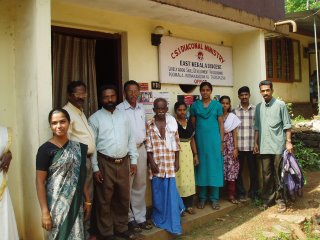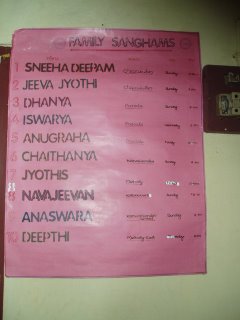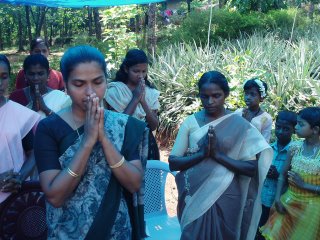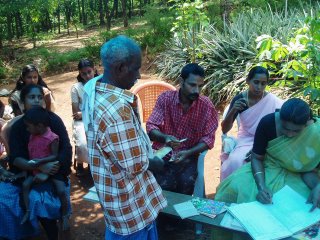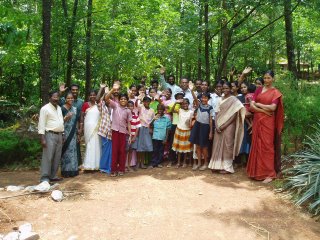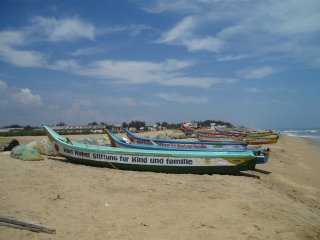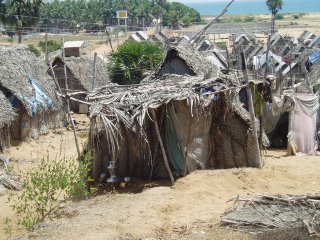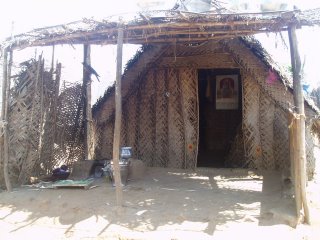The second India Sermon - photos follow:
“The Sangum Gospel”
Acts 4:32-35
Once in a while people will ask us – any of us – if we are happy. It’s a philosophical question to some degree. Although it may also be a genuine inquiry into our mental health. And most all of us – most all the time will answer: “Of course.” Yet – if we were to look at ourselves in the mirror at the very moment – our countenance would tell a different truth – perhaps the reason for the inquiry.
Are we happy?
One of the most obvious questions posed to Donna and myself after our sabbatical has been: “What impressed you most on your trip?” While there were so many things that affected us – upon my return I have realized that I am most struck by the deep sense of joy prevalent among our Indian brothers and sisters and the tragic lack of it – as I have returned to our home culture. The culture shock I have experienced in all of this has been my return to our way of life and to see the ocean of frowns about me. I noticed it as I stood in line at Wegmans – stunned by re-entry into mass consumerism – I gazed about – looking at the people – almost no one was smiling. I wanted to use the public address system and to ask the question of the day: “Are you happy?”. I had the urge to run down the cosmetics aisle and grab the hand mirrors off the hooks and pass them out.
In India Donna and I were amazed at the joy we found – especially in light of the poverty. We would sit at the Bishop’s table each day for our meals and it was clear that money was low – as I mentioned – coconut was served five different ways – a plate of six chicken pieces each smaller than our own chicken wings where served for the three of us [the Bishop’s wife would never sit – she served – another story for another time – suffice it to say she insisted she preferred the curry gravy over the pieces]. Yet with the lack of food and the pressing demands of the Diocese in great deficit there was always joy in the Bishop’s presence and gratitude on his lips. Never did I hear: “We don’t have enough”.
I’ve come back to the sad reports that our church is increasing in its deficit – that we don’t have enough. And I will not even go there this morning – except to place before you the painful contrast I’m feeling and to tell you a story of people who have enough. I assure you that I am and will continue to follow the common lectionary for our sermons and will not pick and choose just to fit these stories that I want to tell.
Let me tell you about the Poomala Sangum. A Sangum as I told the children last week is a group of twenty families who gather each week to support one another and to work together in order to survive in their deep poverty. This is a ministry of the East Kerala Diocese with whom we were working. A community worker and an evangelist go into poor villages and while one shares the gospel the other helps organize families together so that cooperatively they might have a better life. In the village of Poomala there are about ten sangums established. The one in the photograph were they’re waving back at you is the Blessing Sangum. They’re the ones who will receive the money for the coconut crosses we are offering in Trinity Hall so that they can buy banana seedlings and create a small cooperative grove in order to make some money.
They met at a young widow’s home the day I was with them. They meet every week and take attendance in order to remain accountable to one another. Her home is made with wood scraps – the well is about a quarter mile away – the sun shoots its rays through the gaps in the corrugated steel sheets of the roof. She served sweet tea and biscuits and I wondered where she got the 30 rupees it must have cost. But she greeted me with the most sincere smile and honored guest status. At the meeting I came to learn the needs for such every day things such as dry shelter before the monsoons and wells to provide more water in the dry season. I watched one member of each family step up to the sangum secretary and hand over their cooperative savings – each contributes 5 rupees a week [about 12 U.S. cents]. That money is kept for when any of the families have emergencies such as the need for a doctor.
Then the most interesting thing occurred. A woven mat about 4 X 6 was laid out on the bare ground. Then one by one a member of each family would come forward with a cone shaped newspaper filled with about a kilo of rice and they would pour it into the middle of the mat. When they were done there would be 20 kilos of rice – the amount the average family needs for one week. All the while the group would be singing.
The community worker saw how puzzled I was and he giggled a bit and waited for a while before filling me in. This is what the sangums call “rice chitty”. Each day the mother takes a handful of rice from the amount she will cook for the family and sets it aside. Each week one family in the sangum gets the whole batch. By doing this they can save the week’s rice money and use it for something else they need. It was amazing. It was the story in Acts Chapter 4 lived out before my very eyes.
Now if your mind has taken you to a thought that they could achieve the same thing by each family just simply holding back the same amount for themselves and then after 20 weeks have the same amount for their use – then you understand the tragic differences in our cultures.
We work as hard as we can not to answer to anyone and not to depend on others. And it’s not surprising that you and I feel this way. We Americans are a very independent people. Our first act as a nation was a “declaration of independence” with which we told the British to go away because we didn’t need or want them. And every year we celebrate this independence with hot dogs and fireworks.
Not only are we independent as a nation – we’re independent within the nation – a group of persons trying to be independent of each other. We don’t want to need each other.
According to a U.S. Today poll there are about 25 reality based television programs on the air these days. Do you want to guess what the four most popular have been? In fourth place was “Weakest Link” where that annoying British woman shrieks “You are the weakest link – good-bye!” In third place is “The Bachelorette” where an attractive young woman tells men looking for love to look somewhere else. In second place is the ubiquitous Donald Trump saying over and over “You’re fired!” And the most popular reality TV show is . . . drum roll please . . . “Survivor” – every season it has been on – it’s where contestants vote one another off the island.
In every single one of these shows the message is the same: “You are out – go away – I don’t need you – and I don’t want you anymore!”
We are independent and this independence makes us want to reject this early Christian community stuff. It smells like communism anyway. I mean, I’ll come to church to learn about how to get an abundant life – but don’t give me any of this stuff about needing one another or sharing possessions. All that rubs my independent soul the wrong way.
But hold tight for a bit before we dismiss the biblical picture altogether. Just hold tight long enough to see if you know these people. I bet you know them.
These folks live in a fine home in a fine area. Not extravagant - but comfortable. Not cushy – but certainly relaxed. Pretty much everything they want is right at hand and they can afford it. They’re independent. Ask them – though – about the best days of their life and they will tell you it was when they were scraping to get by. Their friends were scraping to get by also so they and their friends traded grocery coupons and hand-me-downs. They shared babysitting and moral support. These were the good old days – the days of connection and community – the days of needing others and having others need us. Do you know these people? You probably do.
Or maybe you know these people. These folks are about to move from one town to another. Instead of calling professional movers they rent a truck – call six or eight friends – put some drinks on ice and set to work. They lift and laugh – they walk and talk. At the end of the day – pizza arrives and the drinks come out and they sit together exhausted for conversation and comfort in each others presence. Do you know these people? You probably do.
The reason you know all these people is the same reason I do. It’s because you – like I – are those people. You – like I – know those times in our lives when it was not our independence – but rather precisely our utter dependence on others – that pulled us through. You – like I – know those times when God’s love shone brightly through others to us and through us to them.
That’s how it was for those early Christians we read about in Acts Chapter 4. They were on an emotional and spiritual rollercoaster. Peter and John – arrested for healing a lame man and preaching the gospel – were brought before the authorities. To everyone’s surprise – the authorities released them. The joyful community immediately went to worship recounting God’s faithfulness throughout history and seeking God’s guidance to help them continue to speak and act with boldness. Their worship is followed by an outpouring of God’s spirit – which energized and embolden the community for even greater witness and ministry.
Luke describes this early church as united in faith and committed to their talk and their walk. With great power Luke says – they gave testimony to the resurrection of Christ. With great commitment they shared so completely that no one was in need. Their walk matched their talk.
Luke is clear. Matching their walk to their talk was possible for this early church because they recognized the grace of God in their lives. “Great grace was upon them” says verse 33. “And so they testified and shared. They needed each other just as they needed God.”
How about us? Does our walk match our talk? It’s not the case that communal living is the only Christian model for how to handle material goods and resources. Even Luke shows at least one other model in his gospel. But it is the case that our emphasis should be on sharing with all so that no one is in need.
How about us? Does our walk match our talk? Quite honestly our budget tells us we’re not there yet. The members of this early church were no longer focused on how they could save enough to acquire what they each wanted. Instead they were focused on living together in ways that mirrored the life of Jesus – one who refused to retreat to the safety of his status as God’s beloved Son – but instead gave of himself so that all would have – and none would be in need.
How about us? Does our walk match our talk? There are two basic ways to learn a skill. One is information based. Just acquire and store information. You might gather data from books on-line or through other non-human sources. In many regards – a second person is not needed to gather or store the information. The second basic way of learning is experience based. With this books and the internet will help you to a point – but there comes a time when someone needs to show you how it goes. Raising a child is experiential learning. It’s best if there are people to watch and wise folks to ask. Or try to learn to golf or fly fish by only gathering data. At some point you need others.
Learning to be Christian is experiential learning. We learn to be Christian in community – because it is less about the information than it is the formation. We learn to be Christian in community – because it is one of those skills best learned in a laboratory of experience and best learned together. We learn to be Christian in community because it’s one of those skills best learned by interacting with others as they and we work at it together.
Christianity is learned by doing and watching and doing again. It’s learned by struggling with others and triumphing with others. While we are together – some of us hesitate. Some of us make excuses. Some seek exemptions. Some try to negotiate. Some even try to hide. But together – we help each other. Together we proclaim this magnificent grace of God that is not even bound by death itself. Together we recognize and we admit that we need each other and only then will we have enough – and only then will we be truly happy. Amen.
Harold M. Delhagen
4/23/06
